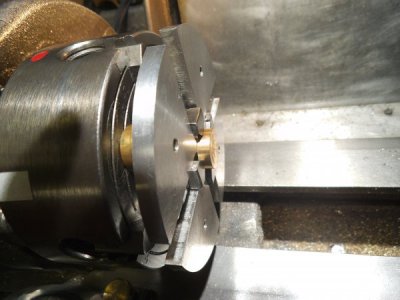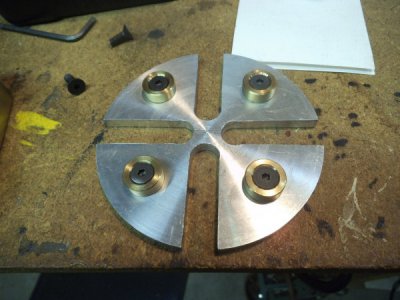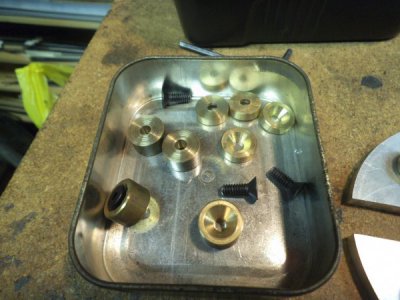-
Welcome back Guest! Did you know you can mentor other members here at H-M? If not, please check out our Relaunch of Hobby Machinist Mentoring Program!
You are using an out of date browser. It may not display this or other websites correctly.
You should upgrade or use an alternative browser.
You should upgrade or use an alternative browser.
Facing Both Sides Of Short Work?
- Thread starter dontrinko
- Start date
- Joined
- Feb 1, 2015
- Messages
- 9,596
Depending on the requirement for parallelness of the two faces, here is what I do. Face drill and tap the first side. Make a threaded mandrel to fit and chuck the mandrel in the lathe. thread the nut on the mandrel and face the second side. If the mandrel is made on t6he lathe, threading include, without removing it the 2nd facing will be perpendicular to the threads.
As an alternative, use a length of threaded rod and thread on three spare nuts. The first nut will go 3/4" or so back from the second nut and the third nut will serve as a jam nut to keep the rod from screwing into the chuck when facing. Thread on your nut and face.
Beware that commercial nuts are not necessarily threaded perpendicular to the faces but the difference is usually inconsequential. If you want true parallelness, using the first approach and facing both sides on the mandrel will be the best approach.
As an alternative, use a length of threaded rod and thread on three spare nuts. The first nut will go 3/4" or so back from the second nut and the third nut will serve as a jam nut to keep the rod from screwing into the chuck when facing. Thread on your nut and face.
Beware that commercial nuts are not necessarily threaded perpendicular to the faces but the difference is usually inconsequential. If you want true parallelness, using the first approach and facing both sides on the mandrel will be the best approach.
If starting with hex stock, why not make the quantity that you need faced on one side, threaded and then parted off a bit long.
To do the second side in a separate operation, chuck up a male screw with the width of a nut hanging out of the chuck.
Screw a semi finished nut on until it butts on the jaws. Face the second side of a nut and the screw to the dimension required. After the first nut is finished the screw will be the index to get all other nuts the same width.
Is similar to what RJ wrote above.
To do the second side in a separate operation, chuck up a male screw with the width of a nut hanging out of the chuck.
Screw a semi finished nut on until it butts on the jaws. Face the second side of a nut and the screw to the dimension required. After the first nut is finished the screw will be the index to get all other nuts the same width.
Is similar to what RJ wrote above.
Last edited:
- Joined
- Nov 26, 2012
- Messages
- 1,307
If your working on a lathe face the first side then drill and counter sink enough so when threaded there is no bur projecting.
Then part it off. It should be very close to right then and if not the parted off side could be faced quickly on a mill as the already faced side is perfect to sit flat on parallels in a mill vise.
Good side down on a mag chuck on a surface grinder would work...not sure anyone would want to get that precise on a nut.
Then part it off. It should be very close to right then and if not the parted off side could be faced quickly on a mill as the already faced side is perfect to sit flat on parallels in a mill vise.
Good side down on a mag chuck on a surface grinder would work...not sure anyone would want to get that precise on a nut.
Thanks for the ideas. Parting on the lathe would be difficult; the work is 1018 and the lathe is a unimat. I pre cut the pieces for the nuts and then faced, drilled and started the tape the one side. Then i took the work out to finish taping. I put the work back and faced the other side.
The thread is M5 .8 . I do not have any screws or rod that size except in the Unimat that I was using to do this.
I could have left the tap part way in, clamp on the tap and face the other side then finish tapping. Thanks; Don
The thread is M5 .8 . I do not have any screws or rod that size except in the Unimat that I was using to do this.
I could have left the tap part way in, clamp on the tap and face the other side then finish tapping. Thanks; Don
- Joined
- Nov 18, 2012
- Messages
- 1,352
If I understand the application perhaps you could use a spider. I made this up for my four jaw independent chuck. The aluminum spider was faced so that both sides are parallel. Then a selection of precision spacers were machined to add to the back of the spider to step it out closer to the front of the jaws and still remain parallel to the chuck body. Seat the small part against the spider.



David



David
- Joined
- Jul 26, 2011
- Messages
- 4,142
I just face the first side. Then,I take 2 parallels of appropriate height,and hold them against the chuck face while pressing the side of the metal(the already faced side) against the parallels. I then tighten the chuck jaws enough to hold the work,tap the work snugly against the parallels with a dead blow hammer,and withdraw the parallels. Then,finish tightening the chuck jaws.
This only works with chucks in GOOD CONDITION. If your chuck has sprung jaws,or has sloppy fitting jaws,the workpiece can move out of place when you do the final jaw tightening.
The device just above is a good idea,better than using parallels (using parallels requires skill). If you can't use the parallels,it would be a good idea to make yourself such an outfit.
This only works with chucks in GOOD CONDITION. If your chuck has sprung jaws,or has sloppy fitting jaws,the workpiece can move out of place when you do the final jaw tightening.
The device just above is a good idea,better than using parallels (using parallels requires skill). If you can't use the parallels,it would be a good idea to make yourself such an outfit.
- Joined
- Sep 29, 2014
- Messages
- 2,102
Soft jaws with a pocket turned or milled in them, better yet use a parting to to face both ends, this will require deburring as a second operation but you would have to do that anyway.
- Joined
- Jul 26, 2011
- Messages
- 4,142
I agree with Wreck Wreck. Jaws with turned recesses are the best thing. But,that is for production work. In the home shop,for a 1 off job,which is mostly what we do in home shops,we can't be messing up expensive chuck jaws,and must find other means to hold work.An alternative to using parallels would be to have flat bar stock that can be used to back up the work,and get it out where the other side can be turned. Then,be able to slide it out between jaws before starting the lathe.
For best accuracy,a light cut taken off one face of the flat bar,or off of both faces if necessary,would better assure parallelism.
For best accuracy,a light cut taken off one face of the flat bar,or off of both faces if necessary,would better assure parallelism.

